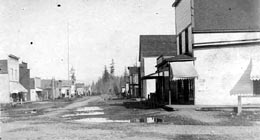On January 7, 1903, the Snohomish County city of Monroe incorporates. Monroe is situated in the valley of the Skykomish River, on the Great Northern Railway line and 15 miles southeast of Everett.
Lumber, Livestock, Butter, Cream, and Produce
By the time of its incorporation in 1903, Monroe claimed 300 citizens, the largest community on the Skykomish River. Settler Henry McClurg had claimed land in 1860 where the Skykomish River and Snoqualmie River met and four years later, he moved inland a few miles and founded Park Place, now a Monroe suburb on the west. When the Great Northern Railway ran its tracks farther east than expected in 1893, the town moved to track side and McClurg renamed the town Monroe, for President James Monroe (1751-1856).
Close to some of Snohomish County’s finest timber and farm land, and with easy access to rail transport, Monroe was well positioned for economic growth. Monroe had grown up with Snohomish County (which began in 1861) and by the early 1900s had a "poor farm," four sawmills, five shingle mills, four general stores, and a weekly newspaper, the Monroe Monitor. Numerous logging camps in the vicinity employed several hundred men year round. Monroe farms provided abundant fruits and vegetables. The town would soon add a creamery to its business ventures.
Persuasion by Fire
On September 16, 1901, the only complete block of businesses in Monroe burned to the ground. Citizens responded to the alarm and saved goods, furniture, businesses, and homes. They kept the fire from spreading, but the devastation clearly pointed out that the town needed a reliable community water system and a fire department. City incorporation was a necessary next step in the city’s growth.
A petition to incorporate went to the Snohomish County commissioners with 78 signatures. The Citizens party and the Good Government party both posted candidates for administrative office and the incorporation issue was presented to the public for a vote on December 20, 1902. It was joked that there were nearly as many candidates as voters, the latter numbering between 129 and 133 (sources differ). The incorporation issue passed and the Citizens ticket was elected for two years:
- Mayor, Nicholas P. Heintz (b. 1858)
- Councilman, W. J. Williams (b. 1874)
- Councilman, Hiram E. Pearsall (b. 1864)
- Councilman, John Brady (b. 1845)
- Councilman, Peter Suhl (b. 1888)
- Councilman, Alpheus H. Buck (b. 1871)
- Treasurer, E. A. Roberts (b. 1867);
- Clerk, R. J. Stretch (b. 1878)
- Marshall, John Daly
Official designation as a fourth-class city was given to Monroe on January 7, 1903.
Council Proceedings
Following incorporation, the new city council began the routine work of drafting ordinances, setting priorities, and assigning salaries. Regular council meetings were scheduled for the second and fourth Wednesday evenings in each month, to be held in the reception room of the Odd Fellows IOOF Hall. Salaried positions included: City attorney, $125 year, clerk, $60 per year, marshal, $50 per month, and treasurer, 1 percent of deposits.
In August 1903 Stephens Hospital (later Monroe General Hospital) was opened and the Monroe State Fair began, precursor of the Evergreen State Fair. Five years later -- in 1908 -- Monroe’s population reached 1,000, a two-story City Hall was dedicated, a condensery began, and Monroe became the home of the new Washington State Reformatory.

